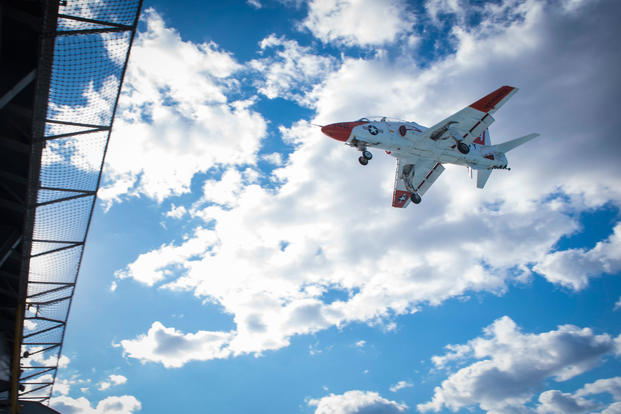Both U.S. Navy and Air Force leadership may be required to present solutions, studies and proposed aircraft modifications in response to a rash of episodes in which pilots experience disorientation and other troubling physical symptoms while flying fighter aircraft, according to a proposal for next year's defense budget bill.
Lawmakers want the Navy to update its F/A-18 Hornet fleet with appropriate technology to help reduce the risk of dangerous, hypoxia-like symptoms, otherwise known as physiological episodes, according to the House Armed Services tactical air and land forces subcommittee markup of the fiscal 2019 National Defense Authorization Act.
The subcommittee also wants to know how the service is progressing in addressing physiological episodes in its T-45 Goshawk trainer, and how the Air Force intends to investigate PEs on its T-6 Texan II trainer fleet and F-35A Joint Strike Fighter, and any other affected aircraft.
The provision would require detailed changes to the Navy's F/A-18 Hornet fleet. Lawmakers want the fighters to be hardwired with an automatic ground collision avoidance system; a replacement of the cockpit altimeter; an upgrade to the onboard oxygen generation system; and a redesign of the aircraft's "life support" systems, required to meet OBOGS input specification, the NDAA markup said.
Related content:
- Lawmakers Rip Brass for Handling of Hypoxia Incidents
- 'A Terrifying Experience': Senator Discusses Navy Hypoxia Demo
- General Tapped to Lead Investigation into Hypoxia Incidents
The Navy would have until Feb. 1, 2019, to make the described changes and would be required every year thereafter to submit a performance report on these initiatives. Navy Secretary Richard Spencer would be able to waive the upgrades only if he justified an alternative, lawmakers said.
The service would have until March 1, 2019, to submit a report to the appropriate congressional defense committees on any modifications made to the T-45 aircraft fleet, as well as associated ground equipment to help mitigate PE risks to pilots.
The Air Force would have the same reporting requirement for its T-6 and F-35 fleets, as well as "any other aircraft ... as determined by the Secretary of the Air Force," the markup said.
The new language comes as both services continue to struggle to find the "smoking gun" on a spectrum of PE problems, and are working with NASA in its research to understand pilot breathing.
While both services have put into place instrumental and medical protocols to try to pinpoint the cause of the problems, the Navy may have made more progress in its search for solutions.
For instance, the Navy fielded the Cobham-made CRU-123 solid-state oxygen monitor on the T-45 to alert aircrew if delivery pressure falls while recording system performance and faults.
Similarly, the service has carried out test flights with a new sensor -- VigilOX, also made by Cobham -- to monitor cockpit and pilot data while in flight.
Meanwhile, there has been no root cause of incidents found among the Air Force's aircraft, according to officials.
"We're not going to stop until we find it," Air Force Chief of Staff Gen. David Goldfein told lawmakers this week.
Since March 1, the number of T-6 hypoxia-like episodes, including disorientation, shortness of breath, confusion and wheezing, has climbed to 13, according to a recent report from Aviation Week.
Separately, more than two dozen A-10 Thunderbolt II attack aircraft at Davis-Monthan Air Force Base, Arizona, didn't fly in late November after two pilots reported they experienced symptoms.
In June, the 56th Fighter Wing at Luke Air Force Base, Arizona, halted operations for all F-35As there after pilots complained of hypoxia-related issues.
-- Oriana Pawlyk can be reached at oriana.pawlyk@military.com. Follow her on Twitter at @Oriana0214.









